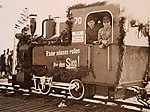| Lundebanen | |
|---|---|
 Opening of the 'Lunde-Bahn' in Farsund, Norway, on 19 April 1943 | |
| Technical | |
| Track gauge | 600 mm (1 ft 11+5⁄8 in) |
The Lundebanen (German: Lunde-Bahn) was a military narrow-gauge railway near Farsund in Norway operated by the German occupying forces during World War II from 19 April 1943.









